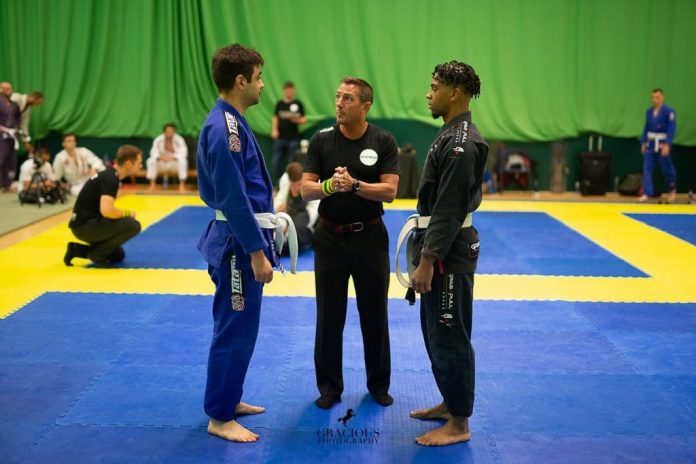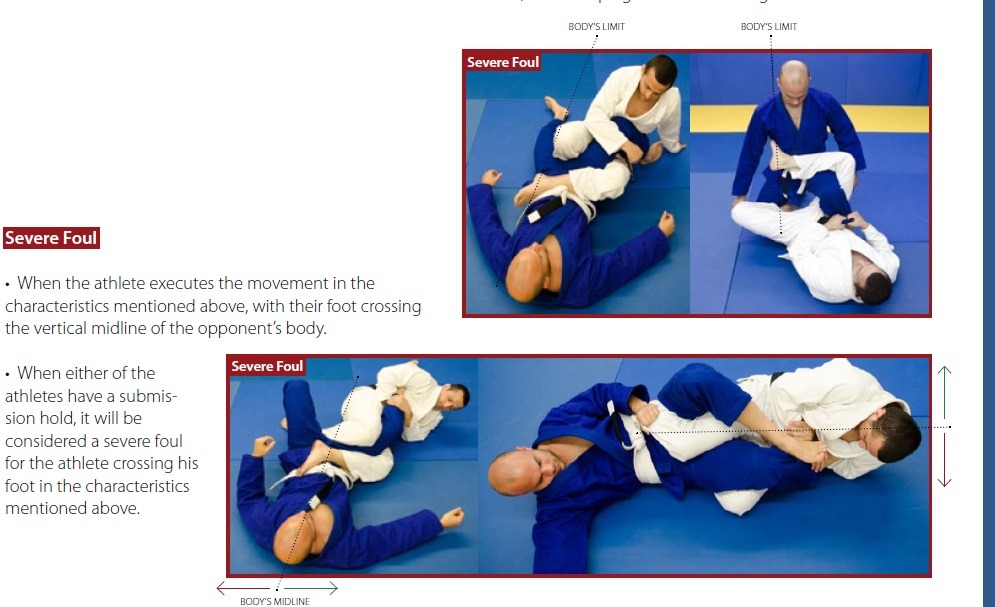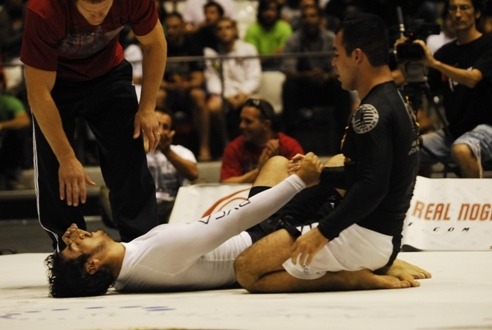
Brazilian Jiu-Jitsu might have started as a self-defense oriented art but it is a full-blown sport nowadays. So much so, in fact, that it has quite a complicated system of rules. Moreover, there are so many organizations out there that use modified rulesets, that it is hard to keep track of them all. For the seasoned grappler, this is nothing that merits extra attention. However, if you’re looking at your first BJJ competition, trying to figure out the basic point system is enough, let alone all possible nuances and variations .to that extent, we’ll go over the rules of BJJ today in a manner that’s very beginner-friendly. After all, we all had to lern the rules. However, we do not all have to take the more complicated road.
To make things simple, there are two main sets of BJJ rules. The first one pertains to Jiu-Jitsu with the Gi, while the second is in terms of No-Gi BJJ. Before we go any further into any off these rules of BJJ competition, let me make one thing clear. Both rulesets belong to different organizations, hence the huge differences in concept. IN fact, BJJ, at least at the moment, lacks a unified governing body. This is the reason why any tournament can use pretty much any rules they want. Still, given the power and reach of two organizations, we’ll go over what’s most commonly accepted. The rules in question re the IUBJJF rules and the ADCC rules.
IBJJF Rules Of BJJ Competition
Let’s start at the beginning. The IBJJF stands for the International Brazilian Jiu-Jitsu Federation. It is run by the people behind Gracie Barra, one of the largest BJJ teams out there. Those people are the direct descendants of Carlos Gracie, namely his son Carlos Gracie Jr. This connection is important in understanding why the rules of BJJ in the Gi favor an approach that’s so different from No-Gi competition. The Gracies are well known for being pretty stubborn in their views. As such, they have a brand of Jiu-Jitsu, now commonly referred to as Gracie Jiu-Jitsu that they like to promote. In those terms, they were also the first ones to create a unified organization like Gracie Barra, as well as the IBJJF, which was the first promotion to organize BJJ tournaments.
Conversely, most of the other promotions that organize Gi events, use the same rules that he IBJJF does. In other words, if you compete in the Gi, you’re either competing in an IBJJF event, A UAEJJF (AJP) event or a local one. In each case, the rule book is the same – The IBJJF one.
While not all Gi tournaments use these rules of BJJ in an exclusive manner, most of them do. The few that use different rulesets are unlikely to interest beginners in the first place. What you need to know is that you might hear from higher belts that he IBJJF rules are not really good, they’re restrictive, etc. It is true that there is some controversy to them, but as a beginner, this should not bother you at all. In fact, the IBJJF rules are the safest set of rules out there, so competitions that abide by them should be your first choice as a white, and even a blue belt.
General Concepts
Let’s begin with some general concepts of BJJ tournaments in the Gi. As mentioned, we’ll be sticking to the IBJJF set of rules of BJJ. First up, tournaments are open for everyone to sign up. Once you do, you’ll have to know your division. That means you’ll need to provide information on your age, sex, belt level, and weight. It is this last one that’s the most important, as the IBJJF weighs you in right before your first match. If you’re even slightly over the weight limit, you’re immediately DQ-ed.
The matches themselves have different lengths, according to belt level and age. For now, let’s stick to length determined by belt level. White belts get 5 minutes to showcase what they’ve learned. As they go up in rank, the matches get longer. Conversely, blue blets have 6, purple belts 7 and brown belts 8-minute matches. 10-minute matches are reserved for black belts.

The Points System
The point system is the meat and potatoes of the rules of BJJ when it comes to competition. This is where most people tend to engage in arguments with referees and look for excuses. IF you understand the system, you can use it to your advantage.
Under IBJJF rules, you can get 2, 3, and 3 points. Two points are for taking someone down, sweeping someone, or getting to the knee on belly position. There’s only one instance where you get three points, an that’s when you pass someone’s guard completely. Finally, the most points (4) are reserved for either the mount or back mount positions. That’s more than enough for you as a beginner.
Often times, people wonder why they did not get points. In order to get the points, you need to actually end up ina very specific position. For example, if you sweep someone, you have to end up on top and keep the other person on the bottom for 3 seconds. The 3-second rule actually applies all over. Whether you pass guard, get to knee on belly, mount or back, you need to keep your opponent there for three seconds. In terms of passing, holding knee on belly and keeping mount that means both your opponent’s scapulae are pinned to the floor. When you find yourself in back control, you need a seatbelt and both hooks in to get all 4 points.
In the cases where you pull off any of the above, but you can’t complete the 3-second rule, you get an advantage instead of points. You can also get advantages for activity and submission attempts. If there are no points at the end of a match, advantages can decide the outcome However, even a single point is worth more than a hundred advantages.
Negative Points And Penalties
One more thing o know about Gi rules of BJJ is that there are negative points and penalties. In certain situations, these can also decide a match (if there are no points or advantages scored, for example). When it comes to negative points, there are many traps you can fall into. The most
The important thing to remember as a beginner, though, is grips. Even if you’re tempted, you mustn’t place four fingers inside the pants or sleeves. That’ll earn you a penalty, and eventually, negative point s in no time. Moreover, stalling is a big one as well. IF you’re in the guard for example and you’re doing nothing for a while, a referee will ask you to work. IF you do not, you’ll eventually end up with negative points again.
There are also a bunch of other instances, mostly concerning illegal moves and gray areas that can earn you negative points. However, fro the time being, focus on your grips and stalling. After all, if you stay out of all restricted attacks, you won’t have to worry about penalties or negative points.
Submission Rules


Otherwise, submissions are the preferred way of winning as you can end a match in seconds if you can sink one in. Otherwise, you either win by points, advantages, lack of negative points, or, if everything is square, by a referee’s decision.
The Fine Print
While we’re talking about the IBJJF rules. Let’s mention a few things that are not often considered important, but may cost you a match. One thing to remember is that, as a beginner, you can’t jump guard. Also, make sure you’re not slamming your opponent’s with their back to the ground, even slightly. Moreover, you have to refrain from talking to the referee during a match if you do not want to earn penalties. In fact, talking to one during a match is going to achieve nothing more than this.
Let’s clear up some match related finer rules of BJJ too. One thing to know is that you can’t leave the mat area, particularly in an attempt to escape a submission. Moreover, do not go looking for points when you do reversals. A reversal is getting on top after you’ve been on the bottom of side control or mount. Unless you’re in guard/half guard, it’s an escape, not a sweep. In other words – no points. Speaking of which do not look for points from side control – it is a pass that brings you three points, not side control itself. Also trying to avoid someone’s guard is going to earn you a penalty. So no going backward without engagement.
Remember that her are more rules than you can fit in your head even as a black belt. Heck, even referees do not know and understand them all. Plus, the rules do change from time to time, meaning nothing’s set in stone. If you remember the above, though, you’ll be more than ready to compete.
Going No-Gi: ADCC Rules
In the opposite corner of the Gi Jiu-Jitsu tournaments are the No-gi ones. In modern times, those mostly involve unique sets of rules, the likes of EBI or Quintet. However, those are mostly invitation-only tournaments, meaning you can’t participate as a beginner anyways. What you can do as a white/blue belt is trying out for the ADCC. The ADCC stands for the Abu Dhabi Combat Club. The Sheiks of the East are huge fans of BJJ and they were really fast to follow the formation of the IBJJF with their own league. ADCC, on the other hand, is completely different gravy than the IBJJF.

The ADCC is held every couple of years at a different spot around the world. Until such time, there are regional and continental ADCC trials which determine who gets a spot. Only four spots per division are available, with the rest 12 reserved for to athletes of the world, who get special invites. However, anyone can sign up for trials, although divisions are not as many as in the IBJJF. Here, you get a weight class, and a spot in either the beginner, intermediate or advanced category. Beginner means white belts, blue and purple go in the intermediate, while brown and black are advanced.
Match Structure
The main structure of ADCC matches is somewhat complex. For now, remember that they have two parts in a match. The first one is a part where you can only win by submission, as there are no points or advantages to be counted. After a certain time, though, points get introduced. That said, while there are both positive and negative points, there are no advantages whatsoever.

A huge thing to remember here is that negative points actually start from the very first second, and they might end up deciding a match.
Point System
The ADCC points system is quite different from that we saw in the IBJJF rules of BJJ. In terms of positive points, the actions that bring you points are pretty similar to those in the IBJJF. The amount of points, though is different. Namely, Getting to mount gets you only two points. Furthermore, back control brings your three points. In terms of sweeps and takedowns, you get different amounts of points depending on where you end up. If you sweep someone and end up in their guard, you only get two points. The same is true for a takedown that gets you into guard/half guard.
However, if you pass the guard following a takedown or a sweep you get four points. Moreover, reversals are considered d points here, which can be huge! However, there are certain similarities with IBJJF rules. Knee on belly and guar passing get awarded the same amount of points in both promotions (2 and 3 points respectively). Also, the 3-second rule applies under ADCC rules of BJJ as well.
Negative points are reserved for big infarctions only. One such example is going to the ground from standing, and doing nothing positive in a period fo three minutes. That will earn you 1 negative point. Similarly to the IBJJF passivity and inactiveness are also big infarctions. Also, like in Gi, there’s a warning that precedes a negative point. Also, you get a negative point straightway for backing out of engagements.
Submission Rules

The aim of the ADCC is to promote submission focused grappling, rather than trying to secure points to win. That’s a huge reason why there are no advantages, and why there’s overtime round to help decide the winner. Still getting DQ-ed at the ADCC is still possible, if you fix a fight with a teammate, for example.
Conclusion
Competing in grappling is lots of fun regardless of the ruleset. In fact, you can sign up for just about any open tournament, Gi or No-Gi. One limitation in NO-Gi IBBJJF events is that you can’t compete without the Gi as a white belt. However, make sure you learn the rules before you step on those mats. Instead of trying to memorize entire rulebooks, focus on what’s important. Talking to seasoned competitors and instructors is always a great idea. However, now you also have a guide to help you understand the most important aspects of being a BJJ competitor. Good luck!
Elite Strength and Conditioning For BJJ Competitors [Sample Plan]


![Darce Choke Encyclopedia – Origins, Mechanics and Variations [2025] BJJ, choke, Brabo, BJJ Darce Choke, D'arce Choke, Darce BJJ Choke](https://bjj-world.com/wp-content/uploads/2017/11/JungPoirierLeeYahoo-218x150.jpg)









![4 Weeks To A Better Guard Travis Stevens DVD Review [2025] 4 Weeks To A Better Guard Travis Stevens DVD Review](https://bjj-world.com/wp-content/uploads/2025/04/4-weeks-to-a-better-guard-travis-stevens-dvd-review-218x150.png)
![DONE! Gordon Ryan Retiring—and Danaher Might Not Be Far Behind! [2025] Gordon Ryan Retiring—and Danaher Might Not Be Far Behind!](https://bjj-world.com/wp-content/uploads/2025/04/LEG-GRABS-3-1-218x150.png)

![6 Most Essential Skills Base Top Dima Murovanni DVD Review [2025] 6 Most Essential Skills Base Top Dima Murovanni DVD Review](https://bjj-world.com/wp-content/uploads/2025/04/essential-skills-base-top-dima-murovanni-dvd-review-218x150.png)

![Cross Ashi Garami Firas Zahabi DVD Review [2025] Cross Ashi Garami Firas Zahabi DVD Review](https://bjj-world.com/wp-content/uploads/2025/04/cross-ashi-garami-firas-zahabi-dvd-review-218x150.png)


![No-Gi Pressure Mastery JT Torres DVD Review [2024] No-Gi Pressure Mastery JT Torres DVD Review](https://bjj-world.com/wp-content/uploads/2024/10/no-gi-pressure-mastery-jt-torres-dvd-review-100x70.png)


![Trip Throw Dilemma Michael Pixley and Heath Pedigo DVD Review [2024] Trip Throw Dilemma Michael Pixley and Heath Pedigo DVD Review](https://bjj-world.com/wp-content/uploads/2024/10/trip-throw-dilemma-michael-pixley-dvd-review-100x70.png)


![Leg Lock Stock And Barrel Taylor Pearman DVD Review [2025] Leg Lock Stock And Barrel Taylor Pearman DVD Review](https://bjj-world.com/wp-content/uploads/2025/03/leg-lock-stock-and-barrel-taylor-pearman-dvd-review-100x70.png)

![Special K Guard Neil Melanson DVD Review [2025] Special K Guard Neil Melanson DVD Review](https://bjj-world.com/wp-content/uploads/2025/03/special-k-guard-neil-melanson-dvd-review-100x70.png)
![Master The Move The American Lock John Danaher DVD Review [2024] Master The Move The American Lock John Danaher DVD Review](https://bjj-world.com/wp-content/uploads/2024/12/the-american-lock-john-danaher-dvd-review-100x70.png)





![Tiny Woman Guide To The Guard Ann Kneib DVD Review [2024] Tiny Woman Guide To The Guard Ann Kneib DVD Review](https://bjj-world.com/wp-content/uploads/2024/11/tiny-woman-guide-to-the-guard-ann-kneib-dvd-review-100x70.png)

![Master Scissor Sweep Ryan Scialoia DVD Review [2025] Master Scissor Sweep Ryan Scialoia DVD Review](https://bjj-world.com/wp-content/uploads/2024/12/scissor-sweep-ryan-scialoia-dvd-review-100x70.png)

![The Empty Half Guard Michael Currier DVD Review [2025] The Empty Half Guard Michael Currier DVD Review](https://bjj-world.com/wp-content/uploads/2025/03/empty-half-guard-michael-currier-dvd-review-100x70.png)
![Front Head Lock Kaynan Duarte DVD Review [2025] Front Head Lock Kaynan Duarte DVD Review](https://bjj-world.com/wp-content/uploads/2025/02/front-head-lock-kaynan-duarte-dvd-review-100x70.png)
![Roger Gracie Guard Passing System DVD Review [2025] Roger Gracie Guard Passing System DVD Review](https://bjj-world.com/wp-content/uploads/2025/02/roger-gracie-guard-passing-system-dvd-review-100x70.png)
![Back Control and Submission Felipe Pena DVD Reveiw [2025] Back Control and Submission Felipe Pena DVD Reveiw](https://bjj-world.com/wp-content/uploads/2025/01/back-control-and-submission-felipe-pena-dvd-reveiw-100x70.png)

![Understanding The Distance On Top Gui Mendes DVD Review [2024] Understanding The Distance On Top Gui Mendes DVD Review](https://bjj-world.com/wp-content/uploads/2024/10/distance-on-top-gui-mendes-dvd-review-100x70.png)

![Closed Guard Reintroduced Adam Wardzinski DVD Review [2025] Closed Guard Reintroduced Adam Wardzinski DVD Review](https://bjj-world.com/wp-content/uploads/2025/01/closed-guard-reintroduced-adam-wardzinski-dvd-review-100x70.png)